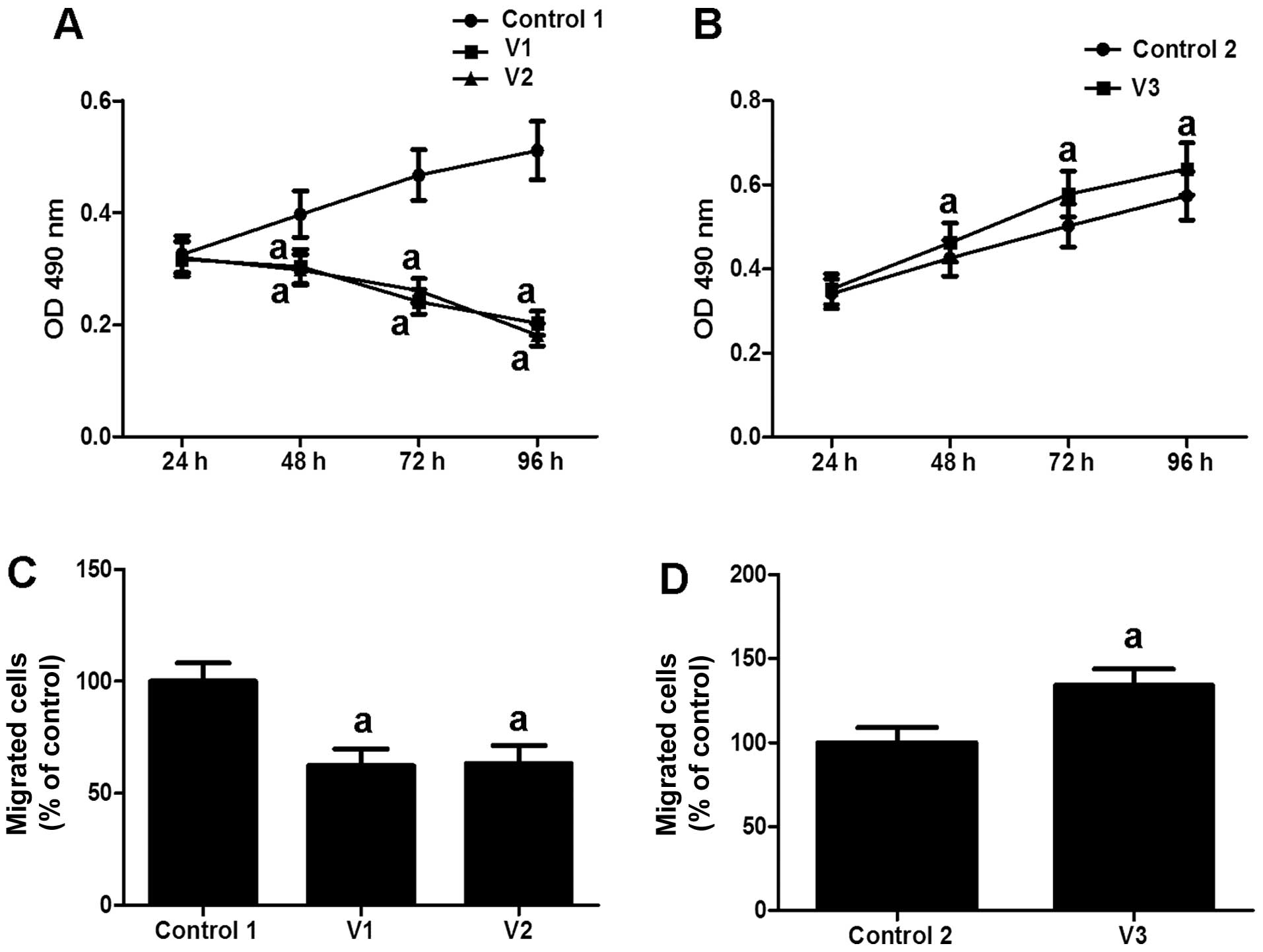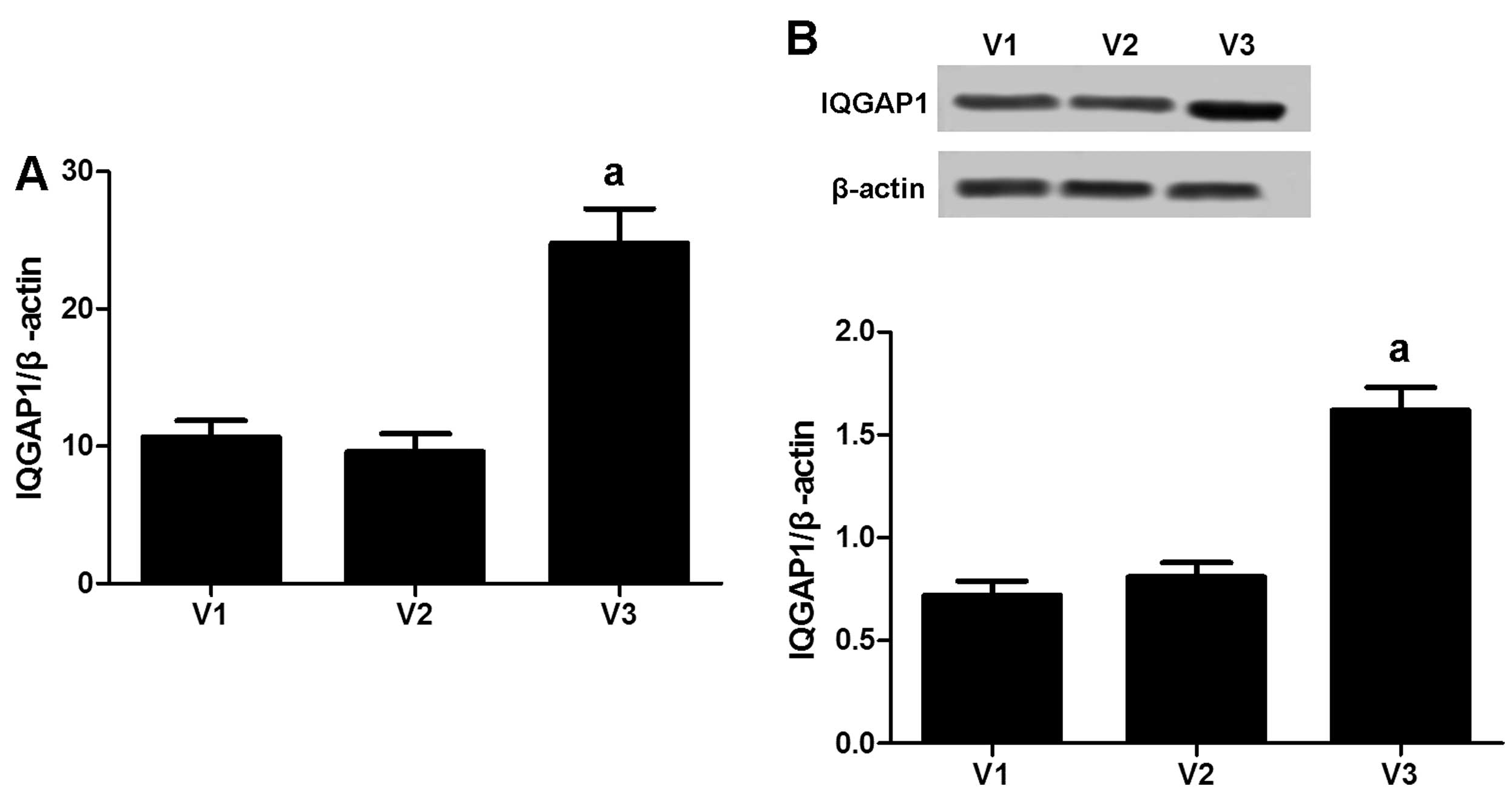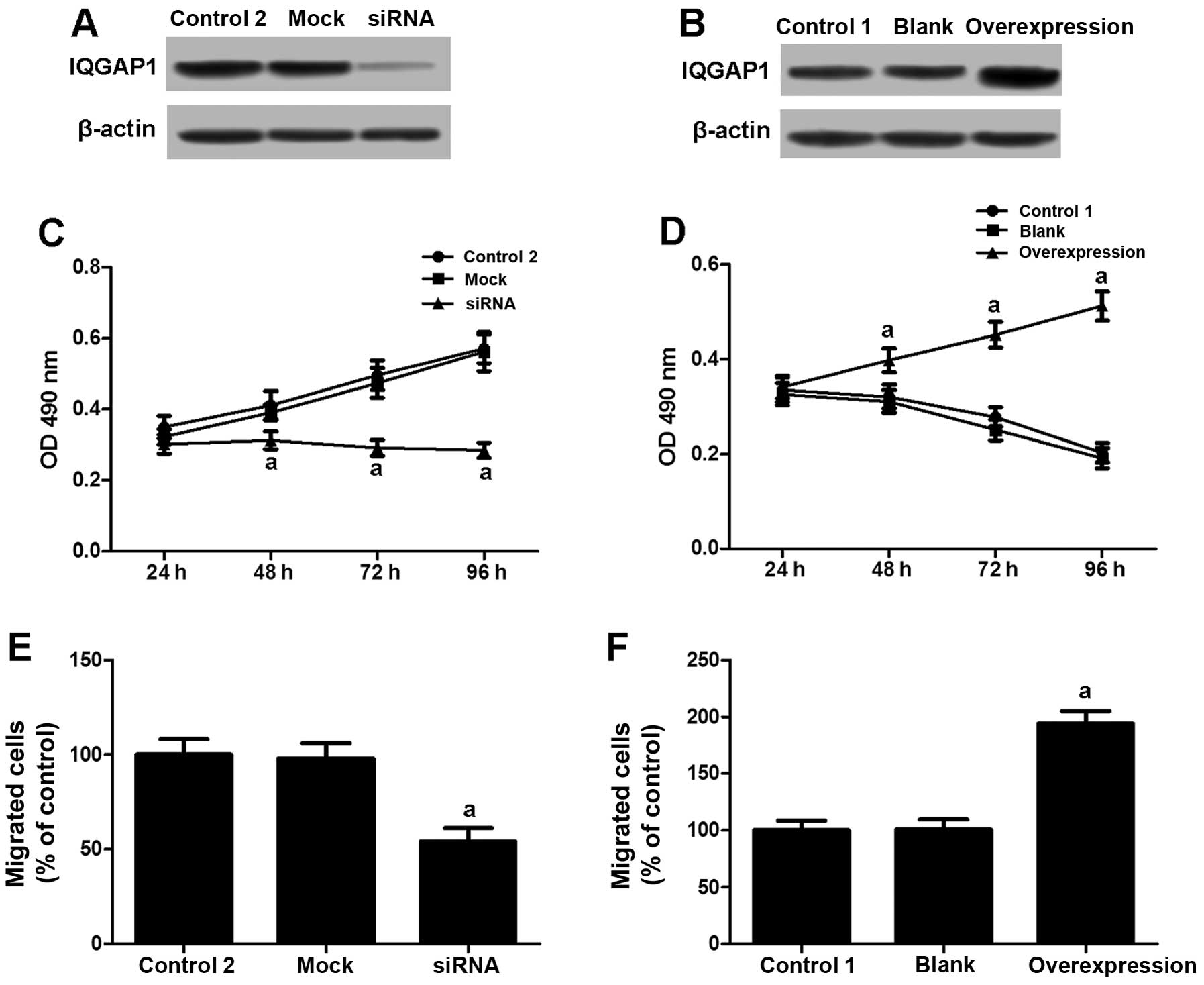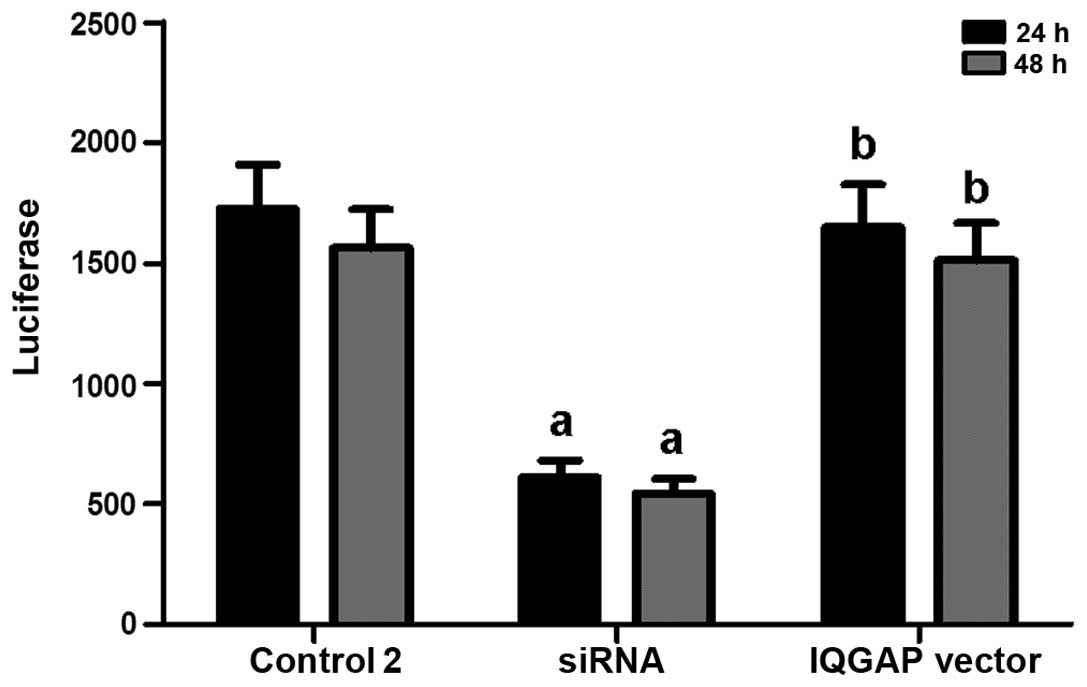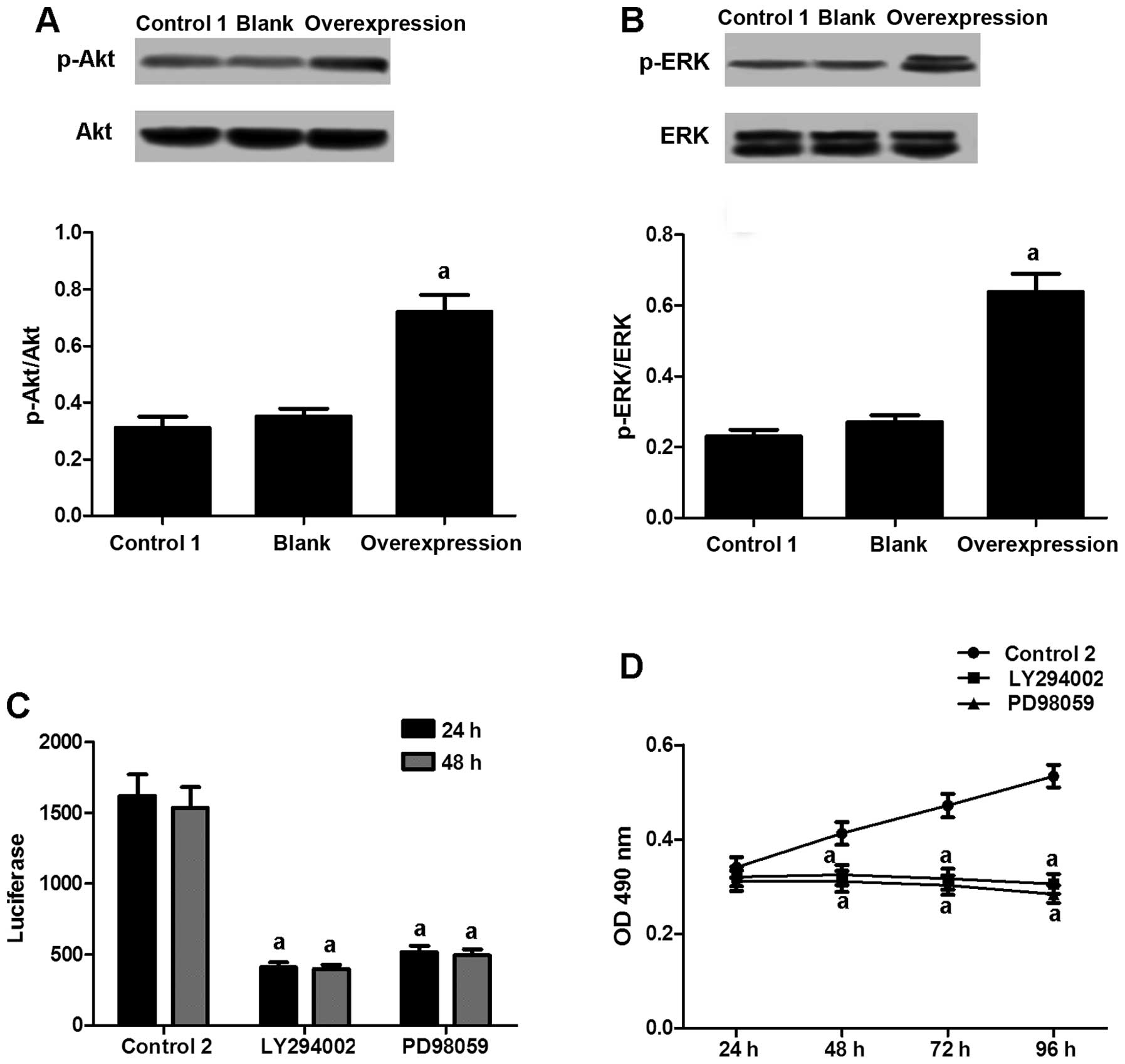IQGAP1 modulates the proliferation and migration of vascular smooth muscle cells in response to estrogen
- Authors:
- Published online on: March 12, 2015 https://doi.org/10.3892/ijmm.2015.2134
- Pages: 1460-1466
Abstract
Introduction
Varicose veins are a common venous disease, with a prevalence of 8.6% among individuals over 15 years of age and as high as 16.4% among individuals over 45 years of age in China (1). Varicose veins are superficial vessels in the lower extremities that are abnormally twisted, lengthened and dilated, and are often associated with incompetent valves within the vein (2). Symptoms of varicosity include swelling, restlessness, limb heaviness and fatigue, an aching/throbbing sensation, burning, tingling, direct tenderness, itching and nocturnal leg cramps (3–5). Furthermore, varicose veins are demonstrated to be autosomal-dominant with incomplete penetrance. Offspring have a 90% chance of developing varicose veins if their parents have them (6–9).
The IQ-domain GTPase-activating protein (IQGAP) family of proteins is found in multiple organisms, including yeast, fish, Xenopus and mammals. Three IQGAP proteins, including IQGAP1, IQGAP2 and IQGAP3, have been identified in humans. All three IQGAPs are comprised of distinct domains, comprising a homology domain (CHD), a polyproline binding region (WW), an IQ domain and a RasGTPase-activating protein-related domain (GRD) (10).
To date, IQGAP1 is the most well characterized of the IQGAP proteins. A list of proteins binding to IQGAP1 has been previously reviewed (10). Nevertheless, the binding of several of these proteins exhibits unique features. A detailed investigation with a panel of >20 mutant proteins revealed that the interactions of Cdc42 and Rac1 with IQGAP1 differ considerably from their interactions with other binding proteins (11). Moreover, IQGAP1 is a scaffold protein modulating the MEK/extracellular signal-regulated kinase (ERK) signaling pathway. IQGAP1 has been shown to bind directly to both MEK1/2 and ERK1/2 and modulates their activation (12,13). Subsequent studies demonstrated that IQGAP1 also interacts with MAPK components proximal to MEK, which is known as Raf (14). Consistent with these findings, IQGAP1 is required for VEGF to activate B-Raf in vascular endothelial cells (15). Additionally, IQGAP1 is involved in the regulation of cadherin-mediated cell-cell adhesion, cell polarization and cell migration (16).
The abnormal growth of vascular smooth muscle cells (VSMCs) plays an essential role in intimal formation in the early stages of atherosclerosis and restenosis, as well as in varicosity (17). Differences in phenotype and function between VSMCs derived from normal veins and those derived from varicose veins have been identified. VSMCs derived from varicose veins are characterized by significantly increased capabilities of proliferation, migration and synthesis (18). In a previous study, it was demonstrated that VSMCs in varicose veins were poorly differentiated, with an increase in secretory cytoplasmic organelles, which possibly reflects the unusual synthetic and secretory roles of VSMCs. A reduction in filament bundles was also observed, which suggests a decreased contractility of VSMCs in varicose veins (19).
Currently, a variety of factors have been shown to modulate the VSMC phenotype, such as microRNAs (miRNAs) (20), estrogen (21), oxidative stress (22) and Ca2+ (23). Among these, the dual effects of estrogen on VSMC proliferation and migration have been reported (24). However, the exact mechanisms involved have not yet been elucidated. In this study, lesion VSMCs were isolated from patients with varicose veins and exposed to 10−8 M 17β-estradiol (E2). Exposure to E2 induced a differential effect on the VSMCs obtained from varicose veins and those obtained from normal veins. Further examination revealed that IQGAP1 expression was significantly increased in the VSMCs obtained from varicose veins compared with the normal VSMCs. The knockdown of IQGAP1 reduced VSMC proliferation and migration, while the overexpression of IQGAP1 promoted both proliferation and migration. The overexpression of IQGAP1 enhanced estrogen receptor (ER) transcriptional activity in the VSMCs obtained from varicose veins. Additionally, elevated levels of phosphorylated Akt and ERK were observed in the VSMCs obtained from varicose veins.
Materials and methods
A total of 11 patients (7 females and 4 males) with varicose veins were enrolled in the present study carried out at the Affiliated Suzhou Hospital of Nanjing Medical University, Suzhou, China. The age of the patients ranged from 51 to 85 years, with an average age of 54.1 years. Varicose veins were obtained during classic vascular stripping surgery. Surplus normal segments of saphenous veins were obtained from 9 subjects (5 females and 4 males) and served as the non-varicose control veins. In all cases, the vena saphena magna was harvested at a location from 5 to 15 cm below the knee. No significant differences in mean age were obseved between the patients with varicose veins and the controls (mean age, 54.1±8.7 and 51.3±9.2 years, respectively). Human umbilical veins were obtained from women (7 subjects; mean age, 27.4±5.9 years) with normal pregnancies after vaginal delivery. The present study was approved by the Ethics Committee of Suzhou Hospital Affiliated to Nanjing Medical University. Informed consent was obtained from all patients prior to enrollment.
Cell culture
The prepared VSMCs were cultured in phenol red-free DMEM containing 10% fetal calf serum, 100 units/ml penicillin, 100 pg/ml streptomycin and 4 mM L-glutamine at 37°C in 5% CO2. The cultures used for the present study had a VSMC purity of >90% (determined by immunocytochemical staining for α-smooth muscle actin). For PI3K or ERK inhibition, VSMCs from varicose veins or normal controls were treated with 10 μM LY294002 or 10 μM PD98059 for 24 h, respectively.
Adenovirus construction
Briefly, IQGAP1 was amplified and subcloned into pAdTrack-CMV, an adenoviral shuttle plasmid, whereas GFP was used as a non-specific control. Subsequently, the recombinant shuttle plasmids pAdTrack-CMV and pAdEasy-1 were homologously recombined in the Escherichia coli strain BJ5183. The recombinant plasmids obtained were transfected into HEK293 cells (Cell Bank of Shanghai Institutes for Biological Sciences, Shanghai, China) to generate recombinant adenovirus. The virus was amplified and purified, and titers were determined using a p24 ELISA kit (Cell Biolabs, Inc., San Diego, CA, USA) before being stored at −80°C for subsequent use.
Small-interfering RNA (siRNA) transfection
Scrambled siRNA and siRNA targeting IQGAP1 (sc-35700) were purchased from Santa Cruz Biotechnology (Santa Cruz, CA, USA). The cells were transfected with scrambled or IQGAP1 siRNA according to the manufacturer’s instructions. Briefly, IQGAP1 siRNA and scrambled siRNA (30 pmol) were diluted in 500 μl DMEM and mixed with 5 μl Lipofectamine RNAi MAX (Invitrogen, Carlsbad, CA, USA). After 15 min of incubation at room temperature, the complexes were added to the cells to a final volume of 3 ml medium. The cells were then harvested at the indicated times for further analysis. The efficiency of the IQGAP1 siRNA was confirmed by western blot analysis of Flag expression.
Transfections and luciferase assays
VSMCs from varicose veins were transfected with a reporter construct containing a luciferase gene (ERE2-TK-LUC) after IQGAP1 expression was knocked down by IQGAP1 siRNA. Subsequently, 10−8 M E2 was added to the culture medium. After these cells were treated for 24 or 48 h, the luciferase activity was assayed according to the manufacturer’s instructions using the luciferase assay system (Promega, Madison, WI, USA).
MTT assay
VSMC growth and proliferation were evaluated by MTT assay. The experiments were carried out in 96-well plates according to the manufacturer’s instructions (Roche GmbH, Mannheim, Germany). For MTT assay, tetrazolium salts were transformed by active enzymes in the cells into intracellular formazan deposits. The cells were incubated for 4 h with the tetrazolium salts. After this incubation time, the purple formazan salts formed became soluble. Absorbance was determined at 490 nm.
Migration assays
The VSMCs were plated in 6-well plates with DMEM. Twenty-four hours after plating, the medium was replaced with DMEM with 0.5% charcoal-stripped fetal bovine growth serum (sBGS) and 18 h after starvation, a single scratch was made using a plastic p200 pipette tip. The cells were washed once with PBS to remove non-adhered cells, and incubated in DMEM with 0.5% sBGS containing 10−8 M E2 or the vehicle (PBS). At 24 h after the scratch was made, bright-field images of 4 different positions for each condition were captured and cell migration was measured as the number of cells that had entered the scratch. Each experiment was repeated 4 times.
Reverse transcription-quantitative polymerase chain reaction (RT-qPCR)
RNA was extracted from the VSMCs using TRIzol RNA-extraction reagent (Gibco, Rockville, MD, USA). Approximately 5 μg of total RNA for each sample was reverse-transcribed into cDNA for RT-qPCR. Quantitative PCR (qPCR) was performed in a final volume of 10 μl, containing 5 μl of SsoFast™ EvaGreen Supermix (Bio-Rad Laboratories, Hercules, CA, USA), 1 μl of cDNA (1:50 dilution) and 2 μl each of the forward and reverse primers (1 mM). The steps in qPCR were performed as follows: 94°C for 2 min for initial denaturation; 94°C for 20 sec, 58°C for 15 sec, and 72°C for 15 sec, and 2 sec used for plate reading for 40 cycles. A melt curve was generated from 65 to 95°C. β-actin was used as a quantitative and qualitative control to normalize the gene expression. All of the primers used in this experiment are listed in Table I.
Western blot analysis
The VSMCs were homogenized and lysed with RIPA lysis buffer (100 mM NaCl, 50 mM Tris-HCl pH 7.5, 1% Triton X-100, 1 mM EDTA, 10 mM β-glycerophosphate, 2 mM sodium vanadate and protease inhibitor). Forty micrograms of protein per lane were separated by 12% SDS-PAGE and electroblotted onto a nitrocellulose membrane (Thermo Fisher Scientific, Waltham, MA, USA). Target proteins were probed using primary antibodies including anti-p-Akt (sc-33437), anti-Akt (sc-5298), anti-p-ERK (sc-16982), anti-ERK (sc-514302), anti-IQGAP1 (sc-10792; all from Santa Cruz Biotechnology) and anti-β-actin (612657; BD bioscience, San Jose, CA, USA). The ECL-plus system (GE Healthcare, Pittsburgh, PA, USA) was used for detection.
Statistical analysis
The results are expressed as the means ± SD. Statistical significance was analyzed using one-way factorial ANOVA or the two-tailed Student’s t-test. A value of P<0.05 was considered to indicate a statistically significant difference. All analyses were conducted using SPSS software (SPSS Inc., Chicago, IL, USA).
Results
Estrogen stimulation differentially regulates VSMC proliferation and migration
Though compelling evidence has elucidated the role of estrogen in vascular protection, elevated estrogen levels have been shown to be associated with vascular remodeling and varicose veins (25,26). In addition, VSMC proliferation and migration play important roles in vascular reforming (27). Therefore, we hypothesized that estrogen may directly influence the physiological function of VSMCs. In order to validate our hypothesis, VSMCs isolated from varicose veins, normal veins and human umbilical veins were either treated or not with 10−8 M E2 for 24 h. At the end of the treatment, cell proliferation and migration were detected by MTT assay and scratch wound motility assay, respectively. Compared with the normal controls (Control 1, 0 μM E2), estrogen markedly inhibited the proliferation and migration rate of the VSMCs obtained from normal veins (V1) and human umbilical veins (V2) (Fig. 1A and C). By contrast, treatment with estrogen markedly promoted the proliferation of the VSMCs obtained from varicose veins (V3 vs. Control 2: lesion VSMCs not treated with E2), as well as VSMC migration (Fig. 1B and D). These results indicate that estrogen has a dual effect on VSMC proliferation and migration.
IQGAP1 is overexpressed in VSMCs derived from varicose veins
IQGAP1 is a scaffold protein that contributes to cell adhesion, cell migration and proliferation. To verify IQGAP1 expression in VSMCs, RT-qPCR was performed to analyze the mRNA level of IQGAP1 in the VSMCs obtained from varicose veins (V3, of 11 patients), normal veins (V1, of 9 patients) and human umbilical veins (V2, of 7 patients). As shown in Fig. 2A, IQGAP1 expression (190 kDa) was significantly increased in the VSMCs obtained from varicose veins compared with those obtained from normal veins and human umbilical veins. These results were further confirmed by western blot analysis (Fig. 2B).
IQGAP1 is involved in the modulation of VSMC proliferation and migration induced by estrogen
A high IQGAP1 expression was demonstrated to contribute to cell proliferation and migration. We then investigated whether IQGAP1 is associated with the regulation of VSMC proliferation and migration induced by estrogen. The VSMCs obtained from varicose veins were transfected with IQGAP1 siRNA and treated with 10−8 M E2 (Fig. 3A). Compared with the controls (lesion VSMCs not treated with E2; Control 2), the depletion of IQGAP1 expression markedly reduced VSMC proliferation (Fig. 3C) and migration (Fig. 3E). Moreover, the VSMCs obtained from normal veins and treated with E2 (V1) transfected with an IQGAP1 overexpression vector (Fig. 3B) attained higher proliferation (Fig. 3D) and migration rates (Fig. 3F). These results suggest that IQGAP1 plays a role in the regulation of VSMCs in response to estrogen stimulation.
IQGAP1 enhances ERα activity induced by estrogen
It has been reported that ER is involved in the promotion of cell growth (24,28). Therefore, we evaluated whether IQGAP1 exerts its effects by regulating ER transcriptional activity. Following the knockdown of IQGAP1, the lesion VSMCs were transiently transfected with a reporter construct containing a luciferase gene regulated by two estrogen response elements (ERE2-TK-LUC) to examine the variations in ERα transcriptional activity. Compared with the controls, cells with a 45% decrease in IQGAP1 expression levels, expressed ERα with a 65% lower transcriptional activity (Fig. 4). However, ERα activity in the VSMCs was restored by the IQGAP1 expression vector (Fig. 4).
IQGAP1 activates ERα in VSMCs through the activation of kinases
To examine the mechanisms through which IQGAP1 promotes ERα activity, we assessed the phosphorylation levels of kinases that promote cell growth, including Akt and ERK. Elevated phosphorylation levels of Akt (Fig. 5A) and ERK (Fig. 5B) were observed in the normal VSMCs transfected with the IQGAP1 overexpression vector. However, treatment with the PI3K (Akt kinase) inhibitor, LY294002, or the ERK inhibitor, PD98059, distinctly suppressed ERα transcriptional activity (Fig. 5C), as well as the proliferation rate of the lesion VSMCs (Fig. 5D). Hence, our results provide evidence of the mediation of ERα activation and VSMC proliferation by kinases.
Discussion
To date, the exact etiology of varicose veins has not been clarified. However, increasing numbers of risk factors, such as hormonal changes, obesity, leg injury, prolonged standing, a highly refined diet and tight undergarments have been reported to be involved in the development of this disease (8,25,26). Hormonal changes, such as elevated estrogen levels, which occur during pregnancy, have been reported to play a major role in the development of varicose veins (27). Alterations in hormonal levels inducing hypertrophy and the growth of the SMC layer in varicose veins have been suggested in different studies (28–31). However, augmented estrogen levels have also been reported to reduce SMC migration and proliferation (17,32,33). These dual or opposite effects of estrogen have also been demonstrated in other cell types (34); however, the mechanisms invovled have not yet been clearly defined. Notably, in the present study we found that the proliferation and migration of the VSMCs obtained from normal veins were inhibited by treatment with E2, while those of the lesion VSMCs were stimulated. These results indicate that estrogen may have dual effects on VSMC proliferation and migration. This effect has also been noted by Zhang et al (24), who claimed that the growth effect induced by estrogen on VSMCs was largely dependent on the estrogen concentration. Additionally, Song et al (35) deduced that the growth-regulating effect of estrogen on VSMCs was dependent on the phenotypic state of the cells.
In the present study, IQGAP1 was shown to be overexpressed in VSMCs obtained from varicose veins compared with those obtained from normal veins or human umbilical veins. Accumulating evidence has identified the role of IQGAP1 in the modulation of cell proliferation and migration. Mataraza et al (36) demonstrated that the overexpression of IQGAP1 in mammalian cells promoted cell migration in a Cdc42- and Rac1-dependent manner. Furthermore, IQGAP1, through interaction with platelet-derived growth factor receptor (PDGFR) and focal adhesion (FA) signaling proteins, has been shown to promote the activation of PDGFR in FAs, as well as FA formation, which results in VSMC migration and neointimal formation following injury (37). Notably, the present study demonstrated that the high expression of IQGAP1 overcame the inhibitory effects on VSMC proliferation and migration induced by E2 in VSMCs derived from normal veins.
We also observed that ERα transcriptional activity was decreased following the knockdown of IQGAP1 expression in the lesion VSMCs, which suggests a regulatory role of IQGAP1 in ERα activation. Further investigation suggested that ERα activation and VSMC proliferation may be attributed to a triggering of kinase activation by IQGAP1. Distinct co-regulatory proteins are recruited to ERα and regulate ERα function by serving as co-repressors or co-activators (38). Accumulating evidence indicates that ERα is associated with interconnected networks of proteins that maintain the structure and function of the receptor and influence estrogen responsive gene expression. Erdemir et al (39) identified that IQGAP1 may directly interact with the nuclear receptor ERα and modulate its transcriptional activation of pS2, PR and cyclin D1.
Collectively, the present study demonstrates the differential modulation by estrogen of VSMC proliferation and migration, in which IQGAP1 plays an essential role. The high expression of IQGAP1 is associated with the increased proliferation and migration of VSMCs exposed to E2. These effects may be attributed to a regulation of ERα activity, as well as kinase activation by IQGAP1. As the induction of VSMC proliferation and migration is essential for the progression of varicosity, IQGAP1 may thus be an effective target for the treatment of varicosity.
References
|
Teng H, Dong J, Li Z and Huang J: Effect of vascular endothelial cells in the occurrence and development of lower extremity varicose veins. China Medical Herald. 10:46–49. 2013. | |
|
Raffetto JD and Khalil RA: Mechanisms of varicose vein formation: valve dysfunction and wall dilation. Phlebology. 23:85–98. 2008. View Article : Google Scholar : PubMed/NCBI | |
|
Ruckley CV: Socioeconomic impact of chronic venous insufficiency and leg ulcers. Angiology. 48:67–69. 1997. View Article : Google Scholar : PubMed/NCBI | |
|
Carpentier PH, Cornu-Thenard A, Uhl JF, Partsch H and Antignani PL: Appraisal of the information content of the C classes of CEAP clinical classification of chronic venous disorders: a multicenter evaluation of 872 patients. J Vasc Surg. 37:827–833. 2003. View Article : Google Scholar : PubMed/NCBI | |
|
Langer RD, Ho E, Denenberg JO, Fronek A, Allison M and Criqui MH: Relationships between symptoms and venous disease: the San Diego population study. Arch Intern Med. 165:1420–1424. 2005. View Article : Google Scholar : PubMed/NCBI | |
|
Kurz X, Kahn SR, Abenhaim L, et al: Chronic venous disorders of the leg: epidemiology, outcomes, diagnosis and management. Summary of an evidence-based report of the VEINES task force Venous Insufficiency Epidemiologic and Economic Studies. Int Angiol. 18:83–102. 1999.PubMed/NCBI | |
|
Hamdan A: Management of varicose veins and venous insufficiency. Jama. 308:2612–2621. 2012. View Article : Google Scholar : PubMed/NCBI | |
|
Lee AJ, Evans CJ, Allan PL, Ruckley CV and Fowkes FG: Lifestyle factors and the risk of varicose veins: Edinburgh Vein Study. J Clin Epidemiol. 56:171–179. 2003. View Article : Google Scholar : PubMed/NCBI | |
|
Cornu-Thenard A, Boivin P, Baud JM, De Vincenzi I and Carpentier PH: Importance of the familial factor in varicose disease. Clinical study of 134 families. J Dermatol Surg Oncol. 20:318–326. 1994. View Article : Google Scholar : PubMed/NCBI | |
|
White CD, Erdemir HH and Sacks DB: IQGAP1 and its binding proteins control diverse biological functions. Cell Signal. 24:826–834. 2012. View Article : Google Scholar : | |
|
Owen D, Campbell LJ, Littlefield K, et al: The IQGAP1-Rac1 and IQGAP1-Cdc42 interactions: interfaces differ between the complexes. J Biol Chem. 283:1692–1704. 2008. View Article : Google Scholar | |
|
Roy M, Li Z and Sacks DB: IQGAP1 binds ERK2 and modulates its activity. J Biol Chem. 279:17329–17337. 2004. View Article : Google Scholar : PubMed/NCBI | |
|
Roy M, Li Z and Sacks DB: IQGAP1 is a scaffold for mitogen-activated protein kinase signaling. Mol Cell Biol. 25:7940–7952. 2005. View Article : Google Scholar : PubMed/NCBI | |
|
Ren JG, Li Z and Sacks DB: IQGAP1 modulates activation of B-Raf. Proc Natl Acad Sci USA. 104:10465–10469. 2007. View Article : Google Scholar : PubMed/NCBI | |
|
Meyer RD, Sacks DB and Rahimi N: IQGAP1-dependent signaling pathway regulates endothelial cell proliferation and angiogenesis. PLoS One. 3:e38482008. View Article : Google Scholar : PubMed/NCBI | |
|
Noritake J, Watanabe T, Sato K, Wang S and Kaibuchi K: IQGAP1: a key regulator of adhesion and migration. J Cell Sci. 118:2085–2092. 2005. View Article : Google Scholar : PubMed/NCBI | |
|
Li QY, Chen L, Zhu YH, Zhang M, Wang YP and Wang MW: Involvement of estrogen receptor-beta in farrerol inhibition of rat thoracic aorta vascular smooth muscle cell proliferation. Acta Pharmacol Sin. 32:433–440. 2011. View Article : Google Scholar : PubMed/NCBI | |
|
Xiao Y, Huang Z, Yin H, Lin Y and Wang S: In vitro differences between smooth muscle cells derived from varicose veins and normal veins. J Vasc Surg. 50:1149–1154. 2009. View Article : Google Scholar : PubMed/NCBI | |
|
Renno WM, Saleh F and Wali M: A journey across the wall of varicose veins: what physicians do not often see with the naked eye. Med Princ Pract. 15:9–23. 2006. View Article : Google Scholar | |
|
Cheng Y, Liu X, Yang J, et al: MicroRNA-145, a novel smooth muscle cell phenotypic marker and modulator, controls vascular neointimal lesion formation. Circ Res. 105:158–166. 2009. View Article : Google Scholar : PubMed/NCBI | |
|
Jiang X, Zhang Y, Hou D, et al: 17beta-estradiol inhibits oleic acid-induced rat VSMC proliferation and migration by restoring PGC-1alpha expression. Mol Cell Endocrinol. 315:74–80. 2010. View Article : Google Scholar | |
|
Branchetti E, Poggio P, Sainger R, et al: Oxidative stress modulates vascular smooth muscle cell phenotype via CTGF in thoracic aortic aneurysm. Cardiovasc Res. 100:316–324. 2013. View Article : Google Scholar : PubMed/NCBI | |
|
Afroze T, Yang G, Khoshbin A, et al: Calcium efflux activity of plasma membrane Ca2+ ATPase-4 (PMCA4) mediates cell cycle progression in vascular smooth muscle cells. J Biol Chem. 289:7221–7231. 2014. View Article : Google Scholar : PubMed/NCBI | |
|
Zhang L, Zhu C, Zhang X, Wan Y and Song J: Dual effects of estrogen on vascular smooth muscle cells: receptor-mediated proliferative vs. metabolite-induced pro-senescent actions. Steroids. 76:309–316. 2011. View Article : Google Scholar | |
|
Hobbs JT: Letter: varicose veins in developing countries. Lancet. 2:2591976. View Article : Google Scholar : PubMed/NCBI | |
|
Ahti TM, Makivaara LA, Luukkaala T, Hakama M and Laurikka JO: Lifestyle factors and varicose veins: does cross-sectional design result in underestimate of the risk? Phlebology. 25:201–206. 2010. View Article : Google Scholar : PubMed/NCBI | |
|
Ciardullo AV, Panico S, Bellati C, et al: High endogenous estradiol is associated with increased venous distensibility and clinical evidence of varicose veins in menopausal women. J Vasc Surg. 32:544–549. 2000. View Article : Google Scholar : PubMed/NCBI | |
|
Wali MA and Eid RA: Changes of elastic and collagen fibers in varicose veins. Int Angiol. 21:337–343. 2002. | |
|
Bastos AN, Alves MM, Monte-Alto-Costa A, et al: α-smooth muscle actin, fibrillin-1, apoptosis and proliferation detection in primary varicose lower limb veins of women. Int Angiol. 30:262–271. 2011.PubMed/NCBI | |
|
Han HC: Twisted blood vessels: symptoms, etiology and biomechanical mechanisms. J Vasc Res. 49:185–197. 2012. View Article : Google Scholar : PubMed/NCBI | |
|
Kowalewski R, Malkowski A, Sobolewski K and Gacko M: Evaluation of transforming growth factor-beta signaling pathway in the wall of normal and varicose veins. Pathobiology. 77:1–6. 2010. View Article : Google Scholar : PubMed/NCBI | |
|
Ueda K, Lu Q, Baur W, Aronovitz MJ and Karas RH: Rapid estrogen receptor signaling mediates estrogen-induced inhibition of vascular smooth muscle cell proliferation. Arterioscler Thromb Vasc Biol. 33:1837–1843. 2013. View Article : Google Scholar : PubMed/NCBI | |
|
Zhao J, Imbrie GA, Baur WE, et al: Estrogen receptor-mediated regulation of microRNA inhibits proliferation of vascular smooth muscle cells. Arterioscler Thromb Vasc Biol. 33:257–265. 2013. View Article : Google Scholar : | |
|
Lewis-Wambi JS and Jordan VC: Estrogen regulation of apoptosis: how can one hormone stimulate and inhibit? Breast Cancer Res. 11:2062009. View Article : Google Scholar : PubMed/NCBI | |
|
Song J, Wan Y, Rolfe BE, Campbell JH and Campbell GR: Effect of estrogen on vascular smooth muscle cells is dependent upon cellular phenotype. Atherosclerosis. 140:97–104. 1998. View Article : Google Scholar : PubMed/NCBI | |
|
Mataraza JM, Briggs MW, Li Z, Entwistle A, Ridley AJ and Sacks DB: IQGAP1 promotes cell motility and invasion. J Biol Chem. 278:41237–41245. 2003. View Article : Google Scholar : PubMed/NCBI | |
|
Kohno T, Urao N, Ashino T, et al: IQGAP1 links PDGF receptor-beta signal to focal adhesions involved in vascular smooth muscle cell migration: role in neointimal formation after vascular injury. Am J Physiol Cell Physiol. 305:C591–C600. 2013. View Article : Google Scholar : PubMed/NCBI | |
|
Heldring N, Pike A, Andersson S, et al: Estrogen receptors: how do they signal and what are their targets. Physiol Rev. 87:905–931. 2007. View Article : Google Scholar : PubMed/NCBI | |
|
Erdemir HH, Li Z and Sacks DB: IQGAP1 binds to estrogen receptor-alpha and modulates its function. J Biol Chem. 289:9100–9112. 2014. View Article : Google Scholar : PubMed/NCBI |



